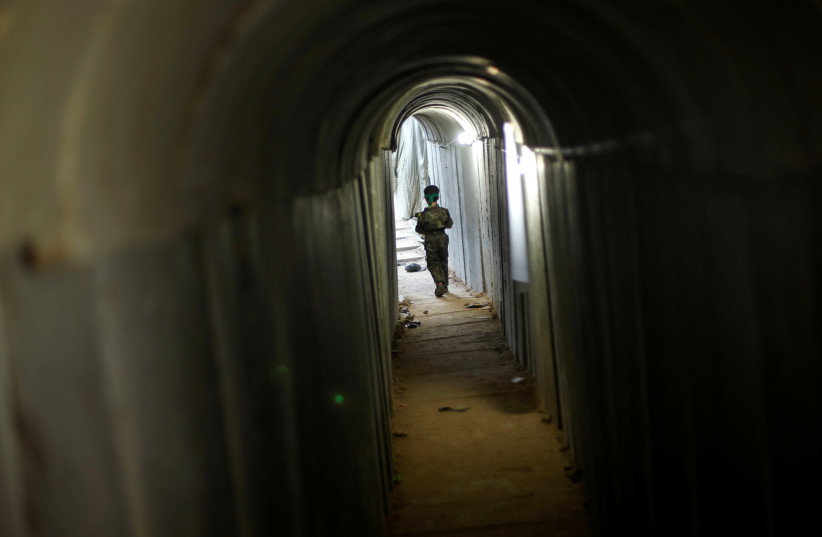Military experts argue that the tunnel network constructed by Hamas is expected to pose one of the greatest challenges for the IDF if there were to be a ground invasion into the Gaza Strip. Apart from the underground facility network of North Korea, Hamas operates what is estimated to be the world's largest tunnel network.
John Spencer, head of Urban Warfare Studies at the Modern War Institute of the United States Military Academy at West Point, stated that the "challenge in Gaza with underground tunnels is unique."
In an article published a few days ago, Spencer, a former officer in the US Army, added that the vast and expanding tunnel network is a problem that has "no perfect solution and awaits the Israeli ground forces."
Estimates suggest that the tunnel network includes 1,300 tunnels, spanning approximately 500 kilometers in total, with some of the tunnels located up to 70 meters underground.
According to reports, most of these tunnels are merely two meters high and two meters wide. Experts believe that the captives Hamas took during the terrorist attack on Israel on October 7 might be held within these tunnels, potentially used as storage places for weapons, food, water, and fuel.
Researchers who have previously investigated Hamas's tunnel network think that some of the organization's leaders are positioned within these tunnels.

Tunnels will further complicate the combat scenario
Experts say that the tunnels will further complicate the combat scenario in the event of an Israeli ground invasion into the Gaza Strip, and Spencer noted that they allow "fighters to move between various different combat sites safely and freely."
Mike Martin, a war psychologist at King's College London, said that "In short, these tunnels balance out by neutralizing Israel's advantages in firepower, tactics, technology, and organization, as well as the risk of being unable to distinguish between military and civilian targets as required by international law. Therefore, the IDF faces challenges regarding military operations within civilian areas, which can be described as three-dimensional warfare."
He explained what he meant by three-dimensional warfare, stating, "There will be elements moving above the living towers and elements operating beneath the ground. If a building is destroyed, it becomes a pile of debris, which then becomes very destructive, in the sense of a place from which any armed person can defend and shoot. 'Urban warfare is one of the most difficult terrains any army could contend with.'"
The tunnels in the Gaza Strip were initially designed to smuggle goods into and out of the coastal enclave and Egypt, but over time, due to increased Israeli aerial surveillance through drones and other electronic espionage equipment, Hamas began to expand the tunnel network. However, the IDF only realized the danger and complexity of these tunnels following the military operation in Gaza in 2014.
As a result, the Israeli government began constructing an underground barrier along the Gaza Strip border to prevent infiltration through tunnels. Experts say it's difficult to locate the tunnels as they might be built beneath various structures, but there are different ways to identify them, such as using ground-penetrating radar and techniques to measure magnetic, thermal, and acoustic fingerprints. However, most of these tunnels are revealed through human intelligence, according to a 2017 conference by the RAND Research Center on the subject.
In this instance, human research, according to the RAND Corporation, was intended to help locate the sudden disappearance of a Hamas activist's phone signal, tracked on its way to the tunnels.
In her book Underground War, Daphne Richmond-Barak, one of the most knowledgeable experts in the field, stated that tear gas or chemicals are used to erase tunnels, but these methods are currently illegal.
Experts say these tunnels can be bombed while Israel possesses what are known as "bunker-buster bombs" designed to penetrate underground. However, considering that the length of the Gaza Strip is about 40 km, its width between 6 and 14 km, and its population is around 2.2 million inhabitants (making the Strip one of the most densely populated areas in the world), it is difficult to facilitate this option even if Israel determines the locations of the tunnels.
According to researchers at the RAND Corporation, Israel has used what's called "precision-guided munitions" in the past to close these tunnels, but they were not highly successful.
The researchers stated that fighting within the tunnels is challenging because they are very dark and cold, exacerbated by gunfire, while using weapons inside causes dust and can be very dangerous. Due to these risks, IDF soldiers were previously only allowed to enter tunnels after being secured by special teams.
Since 2014, the IDF has deployed special combat units for these tunnels, trained around simulated tunnels, and learned to use specific sensors to understand the happenings within the tunnels and specialized elements for fighting within them using robots and dogs.
Spencer noted that he had never heard of an army so well-trained in tunnel warfare as the Israeli military. However, Richmond-Barak wrote in a report to the Financial Times that Israel would "need to engage in a long-term and extensive aerial and ground operation to destroy this underground infrastructure. Even this scenario, which may cause significant casualties, is unlikely to succeed in destroying the entire network of tunnels in Gaza."
Mike Martin agrees that these tunnels represent a significant challenge: "Even though Israel has all the smart methods like drones and confidential information that can be used to locate tunnels, I warn of one thing: there is a gap in the Israeli intelligence system. They made a miscalculation in the scale of an attack of what Hamas did on October 7."
In an interview with Deutsche Welle, he added, "This tells us that they have some blind spots where it seems that after Israel had an information gap, it really won't know what Hamas intends to do or how it plans to defend Gaza or its other plans. So, it seems there are big question marks about what Israel knows and doesn't know."
